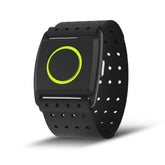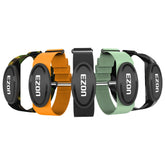Advanced Bouldering Techniques: Watch Insights for Route Mastery
Elevate your bouldering from challenging to commanding with data-driven strategies. Bouldering watches offer real-time insights into route dynamics, finger strength training, and rest intervals, turning every session into a step toward mastery. This guide reveals how to analyze route difficulty like a pro and execute advanced techniques with precision.
1. Route Analysis: Decode the Wall Before You Climb
A. Break Down Movement Patterns
- GPS + Accelerometer Data: Use your watch to record beta for complex routes (e.g., “Dynamic move at hold 5 requires 85% grip strength”).
- Difficulty Scoring: Assign a “stress score” based on heart rate spikes (Zone 4–5, 80–100% MHR) during crux sequences—aim to reduce stress score by 10% per week.
B. Visualize Beta with Digital Logs
- Route Replay Feature: Review climb recordings to identify inefficiencies (e.g., “Excessive swinging at move 3 increases energy expenditure by 15%”).
- Community Sharing: Sync beta with climbing partners via apps to crowdsource solutions for tricky problems.
2. Finger Strength Training: Science Over Suffering
A. Interval-Based Hangboard Training
-
Protocol:
- 4x10-second max hangs on 20mm edges, 90-second rest (heart rate should drop to Zone 2, 60–70% MHR).
- Use watch alerts to maintain strict timing—no “rest creep”!
- Progression: Increase hang duration by 2 seconds/week or switch to smaller edges (15mm).
B. Campus Board Drills for Power
- 3x5 Rung Ascents: Focus on explosive pulls, keeping heart rate in Zone 5 (90–100% MHR) for <20 seconds per rep.
- Recovery Check: Post-set, ensure heart rate returns to 75% MHR within 2 minutes—use watch HR data to validate.
3. Optimize Rest Intervals: The Key to Sustained Performance
A. HRV-Driven Recovery
- High HRV (>50): Short rests (3–5 minutes) between attempts—your body is ready for intensity.
- Low HRV (<40): Extend rests to 8–10 minutes or switch to easier routes to avoid overtraining.
B. Tactical Rest Strategies
- Active Recovery: Use rest periods to stretch or do light dynos (Zone 1–2 activity) to keep blood flowing without fatiguing muscles.
- Nutrition Timing: Consume 20g fast carbs (e.g., sports gel) during rests over 5 minutes to sustain glycogen levels.
4. Mental Toughness: Use Data to Stay Calm Under Pressure
A. Real-Time Feedback for Focus
- Heart Rate Alerts: Set a vibration warning for >90% MHR during climbs to trigger controlled breathing (e.g., 4-7-8 technique).
- Success Metrics: Track “clutch attempts” (routes sent on the 3rd+ try) to build confidence in your mental resilience.
B. Simulate Competition Stress
- Mock Sessions: Replicate comp conditions with timed attempts (e.g., 4-minute burn per problem), using watch data to analyze performance decay.
5. Gear Up for Mastery
A. Bouldering Watch Features
| Feature | Advanced Climber Benefit | EZON Recommendation |
|---|---|---|
| Route Memory | Store 50+ routes with beta notes | EZON Climb Pro Watch |
| Shock Resistance | Withstands falls and impacts | EZON Rugged Climbing Series |
| Grip Force Sensor | Measures finger pressure in real time | EZON Tech Climb Watch |
B. Accessories
- Liquid Chalk: Apply between attempts to maintain grip—track application timing via watch reminders.
- Crash Pad Pressure Sensors: Sync with watches to assess landing force (optional for highballs).
6. Common Mistakes to Avoid
-
Ignoring Warm-Up Heart Rate:
- Solution: Use a 10-minute dynamic warm-up (e.g., traversing) to reach Zone 2 HR before attempting hard problems.
-
Overtraining Fingers on Low HRV Days:
- Solution: Schedule hangboard sessions only on high HRV days (use watch’s daily readiness score).
-
Static Rest Only:
- Solution: Incorporate light movement (e.g., yoga flows) during rests to improve blood flow and mental focus.
7. Sample Advanced Training Week
| Day | Focus | Watch Insight | Finger Strength Work |
|---|---|---|---|
| Monday | Route Analysis | Record beta for V7 problem, identify crux moves | 2x15-second hangs (25mm edge) |
| Wednesday | Power Endurance | 5x3-minute climbs at V6, 2-minute rest | Campus board 4x4 rung drills |
| Friday | Project Day | Track heart rate during redpoint attempts | 3x10-second hangs (15mm edge) |
| Sunday | Recovery & Visualization | Gentle traversing + route mental replay | Foam rolling + finger stretches |
8. FAQs: Your Advanced Bouldering Questions Answered
Q: How often should I train finger strength?
- 2–3x/week, with at least 48 hours between sessions to allow tendon recovery.
Q: Can watches help with dyno accuracy?
- Yes! Use accelerometer data to analyze jump force and trajectory—aim for consistent peak G-force (4–5G) on successful dynos.
Q: Best way to reduce route stress score?
- Practice slow, controlled movements through cruxes during training, even if it feels “too easy”—this builds motor memory and reduces panic-induced heart rate spikes.
Climb Smarter, Not Harder
With a bouldering watch as your coach, every climb becomes a lesson in precision. Use data to decode routes, optimize recovery, and build the finger strength and mental grit needed for elite performance. Remember, mastery isn’t about raw power—it’s about understanding your limits, refining technique, and trusting the process.
Gear up, log your beta, and let every session be a step toward sending that “impossible” project. The wall is just a series of problems waiting for your data-driven solution.
EZON Watch: Professional sports technology brand
https://ezonwatch.com
https://ezonwatch.com









